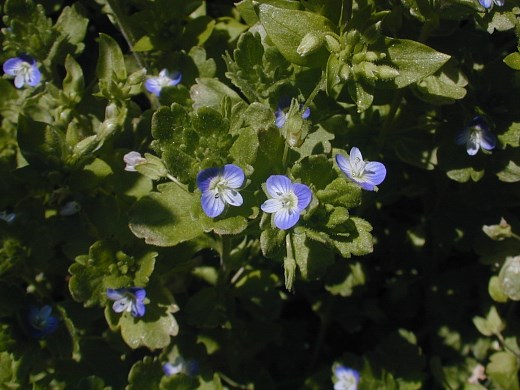Description: This winter or spring annual plant is about 4-12" long, branching occasionally. Mature plants have a tendency to sprawl across the ground. The slender stems are terete and pubescent. The lower leaves are opposite, while the upper leaves are alternate. Individual leaves are up to 1/2" long and 1/3" (8 mm.) across; they are medium to dark green, oval-orbicular, coarsely crenate-dentate, and slightly hairy. The petioles of the leaves are short.

Solitary flowers
develop from the axils of the upper leaves. Each flower is about 1/3"
(8 mm.)
across, consisting of a corolla with 4 petal-like lobes and a calyx
with 4 prominent teeth. The corolla is blue-violet, becoming white
toward the center; it has dark blue-violet lines that radiate from the
center of the flower. One lobe of the corolla is a little smaller than
the others. The reproductive organs consist of a pistil with a single
style and 2 stamens. The teeth of the green calyx are lanceolate and
slightly ciliate; they are shorter than the lobes of the corolla. The
pedicels of the flowers are about ½–¾" in length. The blooming period
typically occurs from mid-spring to early summer and lasts about 1-2
months. Plants tend to fade away during the heat of the summer. Each
flower is replaced by a 2-celled seed capsule that is flattened and
slightly heart-shaped; the
seed capsule is more wide than tall (about 1/3" across and 1/4" tall).
Each cell of the seed capsule contains several small seeds. Individual
seeds are ovoid in shape, but strongly concave on one side. The root
system consists of a mass of slender fibrous roots. This plant
reproduces by reseeding itself, and sometimes forms colonies.
Cultivation:
Bird's Eye Speedwell prefers partial to full sun, moist conditions, and
a rich loamy soil. However, it will adapt to rocky and other kinds of
poor soil. Most vegetative growth and development occurs during the
cool weather of spring, when moisture amounts are higher than average.
Because this species is rather large for an annual Veronica
sp., it does not adapt well to regular mowing.
Range & Habitat:
Bird's Eye Speedwell is widely scattered throughout Illinois. Although
this species is not particularly common, official records probably
underestimate its occurrence within the state. Typical habitats include
nurseries, gardens, edges of yards, moist waste areas, and borders of
foundation walls. This plant is typically found in areas with a history
of disturbance; it is native to Europe.
Faunal Associations:
The flowers attract small bees and various flies. The foliage is not
known to be toxic and is probably eaten by various mammalian
herbivores, particularly rabbits.
Photographic Location:
A flower garden at the Arboretum of the University of Illinois in
Urbana, Illinois.
Comments:
Bird's Eye Speedwell is one of the larger and more attractive weedy Veronica
spp. from Europe. It is distinguished from other weedy
species in this genus by its larger flowers (about 1/3" across) and
longer pedicels (about 1/2" or longer). Another distinctive trait is
the shape of its seed capsules: they are noticeably more wide than
tall. Other Veronica spp. typically have seed
capsules that are at least as tall as they are wide. Like other weedy Veronica
spp., Bird's Eye Speedwell produces solitary flowers from the
axils of its upper leaves. Non-weedy Veronica spp.
are often perennials with larger flowers that are produced from
terminal or axillary racemes. Species in this latter group often prefer
wetland habitats and some of them are native to Illinois.